Unit 04: Yahoo Account
![]()
Professor: Sandro Luis de Sousa, M. A.
![]()
Professor: Sandro Luis de Sousa, M. A.
Managing Messages on-line |
Objetivos:
Conteúdo:
01. LEIA COM ATENÇÃO E SIGA AS INSTRUÇÕES
SOBRE COMO CRIAR UMA CONTA DE E-MAIL NO YAHOO!
02. Follow the Tutorial below to open a Yahoo e-mail account. The
account must have:
2.1. Your first and
last name and the last three numbers of
your student ID in your Login.
Example:
josesouza321@yahoo.com
Learning how to sign up for an e-mail account (Yahoo!) |
01. Open Internet or ExplorerMozilla Firefox, and Type http://www.mail.yahoo.com
02. Click on Sign Up.
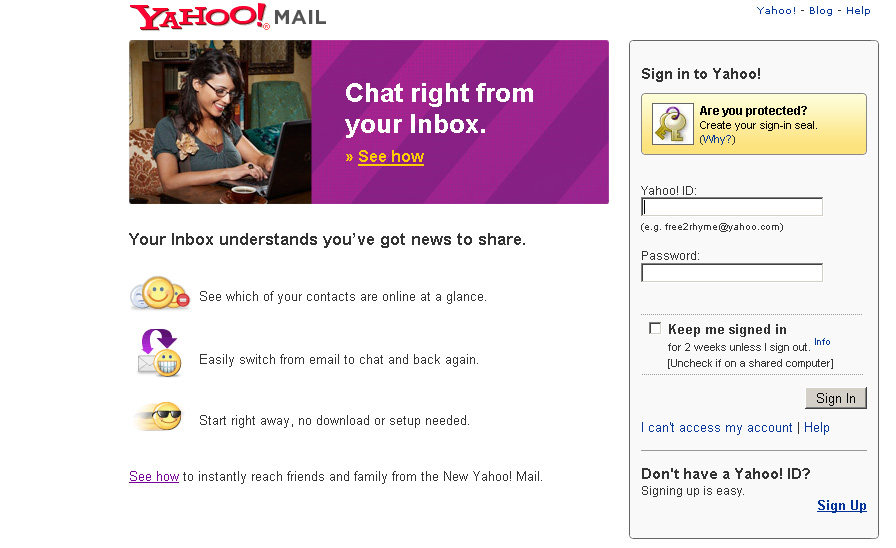
03. Complete the form with your personal information, Choose a gender Male or Female. Select the country as United States from the list.
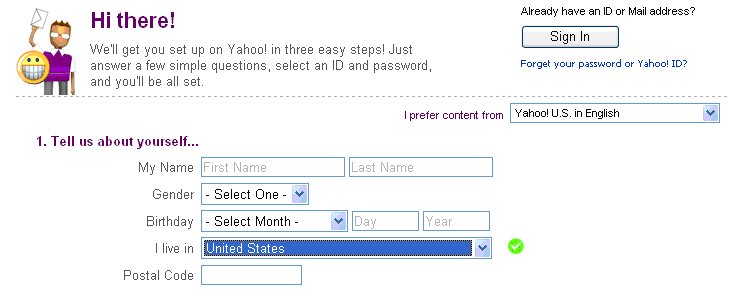
04. Fill in the Postal
Code box with one of these numbers: 04861,
02101, 33013, 02103, 02104,
or 04064.
![]()
05. In the box Yahoo! ID: Write
your first and last names and the last
three numbers of your student identification.
Example: josesouza321@yahoo.com

06. Write a password and Re-type it. Observe the strength of your password, and follow the instructions.

|
NOTE: |
07. After that, Create an alternative e-mail.

08. You will see at the bottom of the page a screen with a code. Enter this code in the box. This is just an example.

09. Check the Do you agree? box. Then, Click the Create My Account Button.

10. After that, you'll see a congratulations message and your account details. Click on Continue.
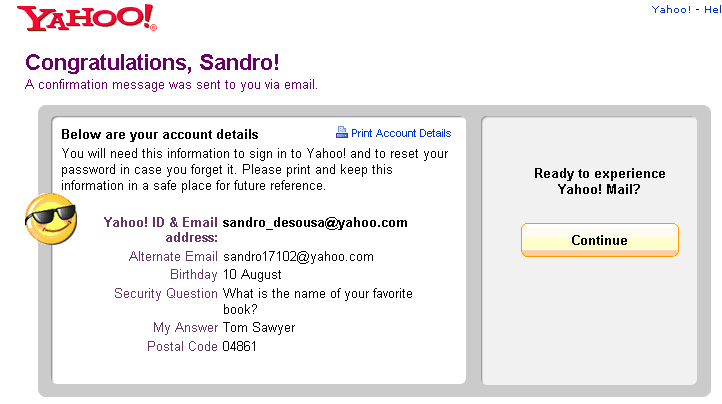
Opening unread messages |
11. Before, you start reading and composing messages, the Yahoo character invites you to take a short tour to see how things work at Yahoo! e-mail. Follow the steps.
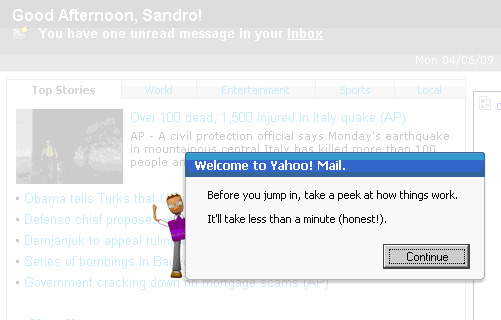
12. After that you’ll see a greeting message. Click on Inbox to check your first message(s).
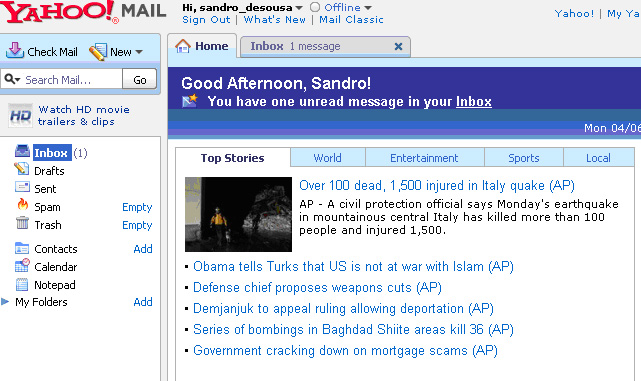
13. You’ll see who the Sender is, what the Subject is, the Date and the Size of the message. Click on the Subject to read the message.

Composing a message |
14. To compose a new message just Click on New (Compose or Reply).

15. If you already have your professor's address in your Address Book, just Click on Contacts
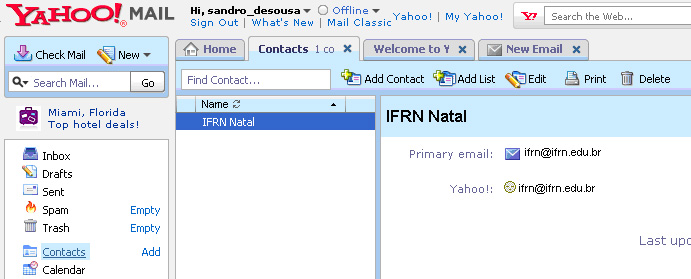 .
.
16. If this is not the case. Let's compose a mesage.
17. Fill in the blanks. Type tour professor's e-mail. If
you want to send Copies to your group of classmates just insert their e-mail
addresses on the Cc or Bcc boxes. Remember to separate them
with commas (,). The subject name must be Vocabulary attached.

18. Now, let's compose
the message. Ask your professor to include your name on his address
book.
For
example: Dear Professor, please include me in your address
book.
Including an attachment in the message and sending it |
19. First, Create
a list of new words (glossary) saved in Word
format on your CEFET Account.
For
Example: 01. Zip code = CEP. 02. Fill in = Completar
03. Contents = Conteúdo . . .
20. Attach the above list (Glossary) in your message. To do that, Click on the Attach button.

21. A window will pop up for browsing the files. Double-click on the File you saved in Word (Glossary) to attach it.
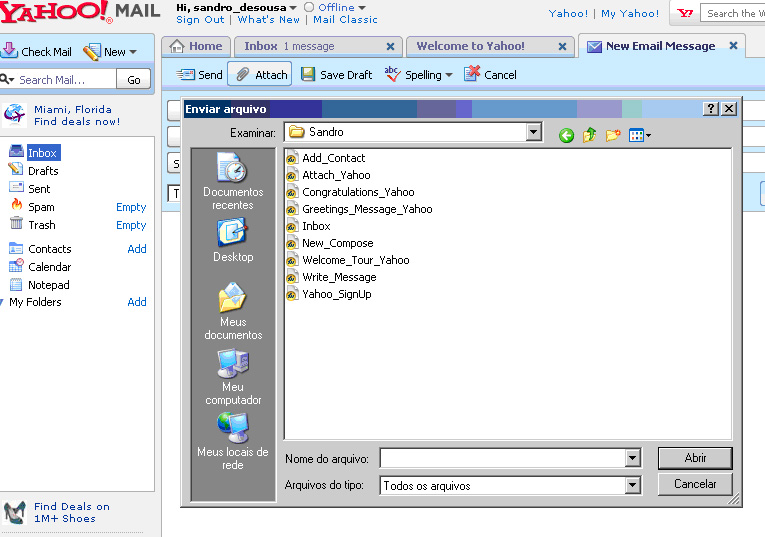
22. The next screen will show the file(s) attached successfully and the total size of the file. You still have the option to Remove the attachment, if necessary.

23. Yahoo! will ask you to enter a character string to secure your message form spammers.
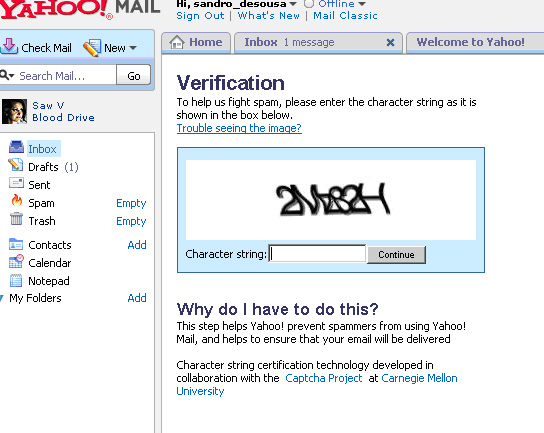
24. Remember: The name of
the Subject must be: Vocabulary Attached.
Your professor's e-mail is: sandro17102@yahoo.com
25. When you finish writing your message Click on the Send button.
26. You’ll see a Message Sent message indicating whom you sent it to. To return to the main page just Click on the Inbox option.
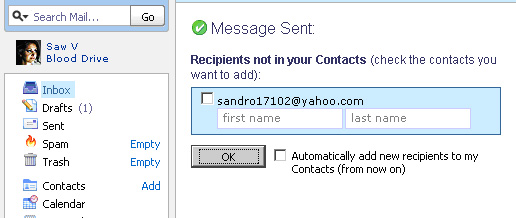
27. If you want to add this person to your address book, Check the box to automatically add new recipients to your contacts.
Checking for viruses and
Saving messages |
28 . Let’s suppose that you have received a message with an attachment.
The first thing that you have to do is to check it for viruses. Click
on the message.

29. Before proceeding Scroll down the page and Click on the file(s) attached to virus-check it..

30. Hopefully, the Scan result will be No Virus Threat Detected.
If this is the case, proceed by Clicking on Download
Attachment.

NOTE: If you
have found viruses, Click on Back to |
31. If NO viruses were found and you clicked on Download Attachment , this screen will pop up. You can either Open it or Save it. The best thing to do is to save it to your student account (G: Aluno) on the LAN (Cefet Local Area Network.).
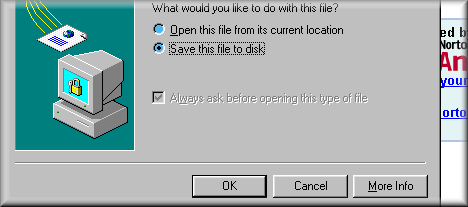
| NOTE: You cannot access your Local Network Student's Account from home. |
| Deleting messages
|
32. To delete a message Select the box or boxes to the left of the Sender option and Click Delete.

33. To delete unsolicited messages (Spams) Select the box
or boxes and then Click Spam.
Signing Out |
34. To leave Yahoo Mail, just Click on the Sign Out option.

Now call your professor (Sandro Luis de Sousa)
to check your new email account. |
![]()
(Adapted from Demetriades, Dinos. Information Technology: workshop. Oxford University Press, 2003)
1. Leia o texto rapidamente. Qual parágrafo (1-4) fornece as respostas para as perguntas (a-d)?
| a. What do the two types of server do? | |
| b. What are the parts of an e-mail address? | |
| c. How many types of e-mail client are there? | |
| d. What happens when you send an e-mail? |
| 1 An internet e-mail address has a user name, the at symbol (@), and a domain name. The user name is the name you choose. The domain mae has two parts separated by a dot (.). The first part is the network that receives the e-mail and the second is the top-level domain (TLD), which shows the type of organization, such as commercial (.com) or educational (.edu). Sometimes the TLD is a country code, such as .cz (Czech Republic). 2 To use e-mail a client computer needs an e-mail program to connect to a network server. The program can be stand-alone, e.g. Outlook Express, or Web-based, e.g. Yahoo. Stand-alone programs let you compose e-mail off-line, but with Web-based programs you must be on-line. 3 E-mail uses two kinds of mail server: an SMTP server, which deals with outgoing e-mail and a POP3 server, which deals with incoming e-mail. SMTP stands for Simple Mail Transfer Protocol; POP stands for Post Office protocol. 4. If you send an e-mail to a friend in the same domain as you, your SMTP server simply send it to the POP3 server in your domain, which adds it to your friend's inbox. If your friend has a different domain name, your SMTP server finds your friend's SMTP server using a Domain Name Service (DNS). When your friend's SMTP server receives the e-mail, it sends your e-mail to its POP3 server which adds it to your friend's inbox. |
2. Decida se as orações são True (T) ou false (F).
| a. You cannot choose your own user name. | |
| b. The domain name shows the network. | |
| c. .edu and .com are TLDs. | |
| d. A DNS sends an e-mail to a POP3 server. |
3. Nomeie as partes do e-mail address.
| 1. | 2. | ||
| Katrina123 |
@ |
hotmail.com | |
|
|||
| 3. | 4. | ||
4. Combine as palavras destacadas no texto com as suas definições (1-4).
| 1. means | |
| 2. a computer on a network | |
| 3. takes care of in some ways | |
| 4. a computer that runs a network |
5. Encontre as palavras no texto que são antônimas das palavras usadas abaixo.
| 1. offline | |
| 2. Web-based | |
| 3. incoming | |
| 4. receive | |
| 5.different |
6. Work in pairs now. Look at the following European country codes. Discuss which countries they could stand for. Use an Internet search engine to find out a list of Internet Country Codes. Write down your answers in a Word format document.
.at - .be -
.bg - .de - .dk -
.es - .fr - .gr -
.hu - .it - .lu - .nl
- .pt - .ro - .si
- .uk |
Home
A: Plano de Ensino
B: Personal Details Form
Unit 01: Creating a Folder
Unit 02: Word Building
Unit 03: Types of Computer
Unit 05: Parts of a Computer
Unit 06: Keyboard and Mouse
Unit 07: LANs and WANs
A Game: Hangman
Unit 08: LANs and WANs 02
Unit 09: LANs and
WANs 03
Unit 10: Designing Webpages
Unit 11: Reviewing Websites
Unit 12: Basic HTML
Ladies and Gentlemen...The Beatles
Test
S@ndroSousa